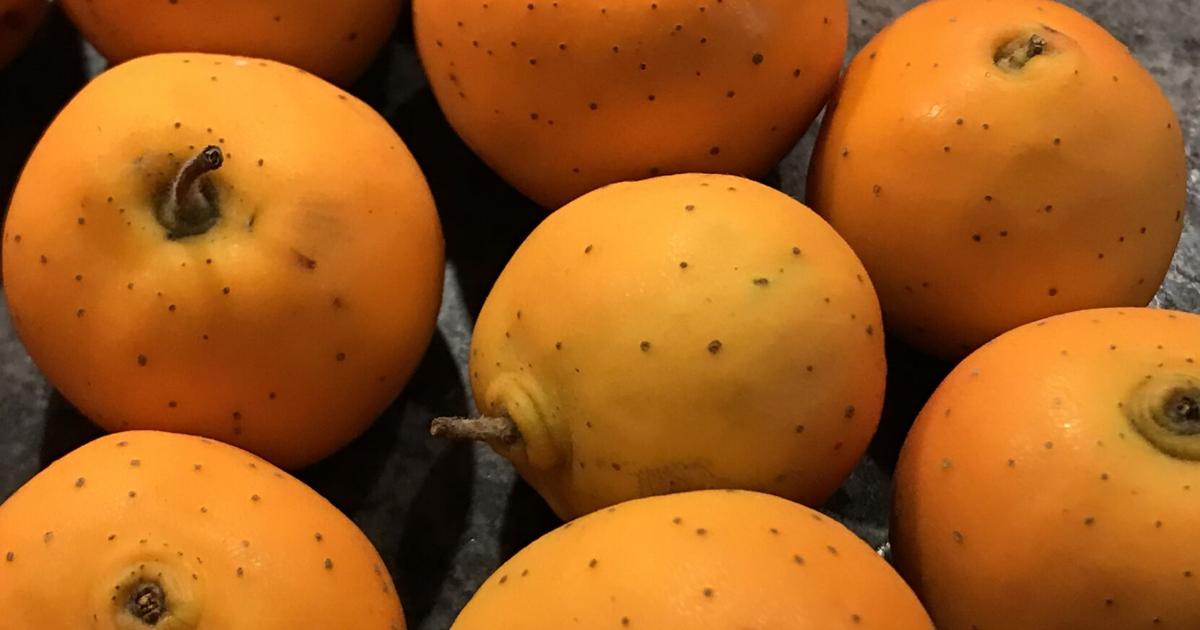
So there I was, again, wandering down the aisles of my nearby (2 blocks away) tienda. It’s called “Super Acapulco”, and they have just about everything you could want in a Latin American grocery store. In this place I seem always to spend most of my time in the produce section, and of course that’s where the avocados, limes, and hot peppers are. And this time, it being near Christmas, there was something new.
One of the vegetable bins contained these fruits, conspicuously bright gold-orange, and speckled (the speckles are naturally a part of the skin), shaped like little plump apples, and with that sort of crabapple look: a stem end and a little bumpy place down at the bottom. My curiosity got the best of me, and I knew I wouldn’t get out of the store without some. I tried one right there.
The taste was sort of apple-y, and its flesh a bit mealy, and a little dry. Technically, this fruit is indeed similar to an apple: it’s called a “pome”, structurally akin to apples, pears, quince, and found only in members of the rose family. This fruit comes from a small tree native to the highlands of central Mexico and Guatemala. It is, in fact, a species of hawthorn, and we have plenty of our own species of “haws” here in the Southeast. Our Mexican hawthorn is of seasonal interest in Central America, because the ripe fruits are an important ingredient in winter and especially Christmastime, as an ingredient in a wonderful hot punch, or ponche navideño.
The Spanish word “ponche” comes from the English word. (By the way, the English word “punch”, as in the stuff you drink, probably came from their early colonial interests, in India. It seems that they had a hot drink made from water, sugar, fruits, spices, and citrus juice. About five ingredients, and “punch” is derived from a Hindi word for “five”.)
Although our mysterious fruit is perfectly edible raw, it is best used as a cooked ingredient. Of course I’m not much of a cook, but I figured that cooking these fruits into a punch might be fun, and maybe even easy. I was right on both counts.
I cut these things up, washed but without peeling, and dug the seeds out of each. (As with apples, there is a little “core” inside.) Then I chopped up a big apple, again without peeling, and added the fruits to a pot of simmering water. Next, about 2 cups of brown sugar, some cloves, a sliced lemon, and a handful each of raisins, dried cranberries, dried hibiscus flowers, along with a bit of allspice and several cinnamon sticks. It simmered and simmered for an hour or so, rendering a fantastic holiday fragrance, and more importantly, a dark, almost syrupy brew. Strain it all out, and serve it hot, along with some of the cooked fruit, in your favorite mug. It could be a new kitchen tradition for your winter holidays. ¡Felices celebraciones!
John Nelson is the retired curator of the Herbarium at the University of South Carolina, in the Department of Biological Sciences. As a public service, the Herbarium offers free plant identifications. For more information, visit www.herbarium.org or email johnbnelson@sc.rr.com.
"fruit" - Google News
December 28, 2022 at 09:00AM
https://ift.tt/iWS7IGh
Mysterious fruit from the highlands of Mexico and Guatemala - Charleston Post Courier
"fruit" - Google News
https://ift.tt/WKOLQnh
https://ift.tt/6oPD0Qu
Bagikan Berita Ini















0 Response to "Mysterious fruit from the highlands of Mexico and Guatemala - Charleston Post Courier"
Post a Comment